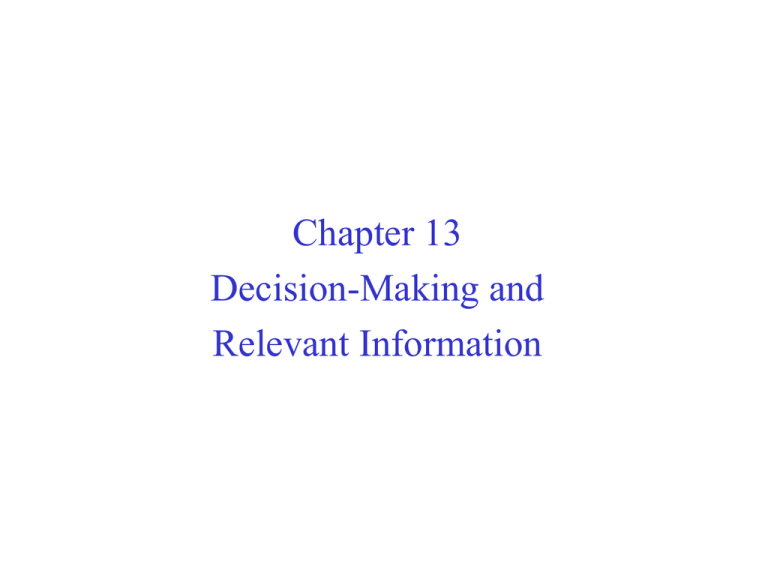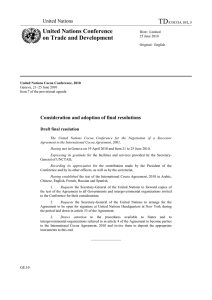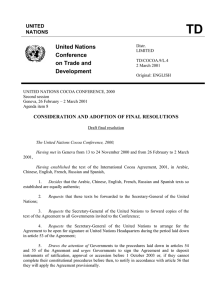Chapter 13 Decision-Making and Relevant Information
advertisement

Chapter 13 Decision-Making and Relevant Information DIFFERENTIAL COSTS AND REVENUES Bill is currently employed as a lifeguard, but he has been offered a job in an auto service center in the same town. The differential revenues and costs between the two jobs are listed below: Lifeguard Monthly salary Auto Service Center Differential costs and revenues $1,200 $1,500 $300 30 90 60 Meals 150 150 0 Apartment rent 450 450 0 0 50 50 10 0 640 740 100 $ 560 $ 760 $200 Monthly expenses: Commuting Uniform rental Union dues Total monthly expenses Net monthly income (10) Identifying Relevant Costs Automobile Costs (based on 10,000 miles driven per year) 1 2 3 4 5 6 Annual straight-line depreciation on car Cost of gasoline Annual cost of auto insurance and license Maintenance and repairs Parking fees at school Total average cost 7 8 9 10 11 12 13 Annual Cost of Fixed Items $ 2,800 1,380 360 Cost per Mile $ 0.280 0.050 0.138 0.065 0.036 $ 0.569 Some Additional Information Reduction in resale value of car per mile of wear Round-trip train fare Cost of hotel in New York Cost of putting dog in kennel while gone Benefit of having car in New York Hassle of parking car in New York Per day cost of parking car in New York $ 0.026 $ 104 $ 200 $ 40 ???? ???? $ 25 Total and Differential Cost Approaches The management of a company is considering a new labor saving machine that rents for $3,000 per year. Data about the company’s annual sales and costs with and without the new machine are: Sales (5,000 units @ $40 per unit) Less variable expenses: Direct materials (5,000 units @ $14 per unit) Direct labor (5,000 units @ $8 and $5 per unit) Variable overhead (5,000 units @ $2 per unit) Total variable expenses Contribution margin Less fixed expense: Other Rent on new machine Total fixed expenses Net operating income Current Situation $ 200,000 Situation With New Machine $ 200,000 Differential Costs and Benefits - 70,000 40,000 10,000 120,000 80,000 70,000 25,000 10,000 105,000 95,000 15,000 15,000 62,000 62,000 18,000 62,000 3,000 65,000 30,000 (3,000) (3,000) 12,000 $ $ Add or Drop a Product Line Discount Drug Company has three major product lines. What can be done to improve the company’s overall performance? Total 250,000 Drug 125,000 Product Line Cosmetics 75,000 105,000 145,000 50,000 75,000 25,000 50,000 Less: Fixed Expenses Salaries Advertising Utilities Depreciation – fixtures Rent Insurance Administrative Total 50,000 15,000 2,000 5,000 20,000 3,000 30,000 125,000 29,500 1,000 500 1,000 10,000 2,000 15,000 59,000 12,500 7,500 500 2,000 6,000 500 9,000 38,000 8,000 6,500 1,000 2,000 4,000 500 6,000 28,000 Net Op Income (Loss) 20,000 16,000 12,000 (8,000) Sales Less: Variable Expenses Contribution Margin Housewares 50,000 30,000 20,000 Add or Drop a Product Line Which fixed expenses in Housewares will Discount Drug be able to avoid? Total Unavoidable Avoidable Salaries 8,000 8,000 Advertising 6,500 6,500 Utilities 1,000 1,000 Depreciation - fixtures 2,000 2,000 Rent 4,000 4,000 Insurance General Administrative Total Fixed Expenses 500 500 6,000 6,000 28,000 13,000 15,000 Add or Drop a Product Line • Contribution margin lost if housewares line is discontinued $ • Less fixed costs that can be avoided if the housewares line is discontinued $ • Inc/(Dec) in overall company net operating inc. $ DECISION RULE: • The Housewares Line should be dropped only if the fixed cost savings exceed the lost contribution margin. “Make or Buy” Decision • Essex manufactures part 4A that is currently used in one of its products. • The unit cost to make this part is: Dire $$ 99 Direct ct m maate teria rials ls Dire 55 Direct ct la labor bor Va 11 Varia riable ble ove overhe rheaadd De 33 Depre precia ciation tion of of spe specia ciall eequip. quip. Supe 22 Supervisor's rvisor'ssa sala lary ry Ge 10 Gene nera rall fa factory ctory ove overhe rheaadd 10 Tota $$ 30 Totall cost cost pe perr unit unit 30 “Make or Buy” Decision • The special equipment used to manufacture part 4A has no resale value • General factory overhead is allocated on the basis of direct labor hours • The $30 total unit cost is based on 20,000 parts produced each year • An outside supplier has offered to provide the 20,000 parts at a cost of $25 per part • Should we accept the supplier’s offer? Pop Quiz Konrade’s Engine Company manufactures part TE456 used in several of its engine models. Monthly production costs for 1,000 units are as follows: Direct materials $ 40,000 Direct labor 10,000 Variable overhead costs 30,000 Fixed overhead costs 20,000 Total costs $100,000 It is estimated that 10% of the fixed overhead costs assigned to TE456 will no longer be incurred if the company purchases TE456 from the outside supplier. Konrade’s Engine Company has the option of purchasing the part from an outside supplier at $85 per unit. The maximum price that Konrade’s Engine Company should be willing to pay the outside supplier is: a. $80 per TE456 part. b. $82 per TE456 part. c. $98 per TE456 part. d. $100 per TE456 part. Accept or Reject a Special Order Jamestown Candleworks has just received a request from the Williamsburg Foundation for 800 candles to be used in a special event for major donors. The candles will be used as the only illumination in the reception room and will be given out as gifts to the donors as they leave. The candles will be imprinted with the Williamsburg Foundation logo. This sale will have no effect on the company’s normal sales to retail outlets. The normal selling price of a candle of about the size and weight of the special candles is $3.95 and its unit product cost is $2.30, as shown below: Direct materials Direct labor Manufacturing overhead Unit product cost $1.35 0.15 0.80 $2.30 The variable portion of the manufacturing overhead is $0.05 per candle; the other $0.75 represents fixed manufacturing costs that would not be affected by this special order. Accept or Reject a Special Order (continued) Jamestown Candleworks would have to order a special candle mold in which the Williamsburg Foundation logo is inscribed. Such a mold would cost $800. In addition, the Williamsburg Foundation wants a special wick containing goldlike thread that would add $0.20 to the cost of each candle. Because of the large size of the order and the charitable nature of the work, the Williamsburg Foundation has asked to pay only $2.95 each for this candle. If accepted, what effect would this order have on the company’s net operating income? Accept or Reject a Special Order Your firm has the capacity to produce 10,000 pencils monthly. It’s December 15th. To date your firm has orders for 8,000 pencils. You don’t anticipate getting any more orders until next January. Your cost and revenue information is as follows: Sales price per pencil $ 10 Variable cost per pencil 3 Total fixed costs $28,000 Accept or Reject a Special Order Jack Frost,Mayor of Burnsville, comes to you and says he would like to give all his staff pencils as Christmas presents, but doesn’t want to pay a lot for them. He offers you $4 per pencil for 2,000 pencils. Should you take this deal? Accept or Reject a Special Order What if, instead, Jack Frost says he will give you $4 per pencil for 4,000 pencils. Should you take this deal? Scarce Resource Constraint A company has two products: a plain cellular phone and a fancier cellular phone with many special features: Selling price Variable costs Contribution margin Contribution-margin ratio Plain Phone $ 80 64 $ 16 20% Fancy Phone $ 120 84 $ 36 30% Scarce Resource Constraint Suppose annual demand for phones of both types is more than the company can produce in the next year. Only 10,000 hours of capacity are available If in one hour plant workers can make either three plain phones or one fancy phone, which phone is more profitable? Scarce Resource Constraint 1. Units per hour 2. Contribution margin per unit Contribution margin per hour Total contribution for 10,000 hours Plain Phone 3 Fancy Phone 1 $16 $36 Pop Quiz Colonial Heritage makes reproduction colonial furniture from select hardwoods. Chairs Selling price per unit $80 Variable cost per unit $30 Board feet per unit 2 Monthly demand 600 Tables $400 $200 10 100 The company’s supplier of hardwood will only be able to supply 2,000 board feet this month. Is this enough hardwood to satisfy demand? a. Yes b. No Pop Quiz Chairs Selling price per unit $80 Variable cost per unit $30 Board feet per unit 2 Monthly demand 600 Tables $400 $200 10 100 The company’s supplier of hardwood will only be able to supply 2,000 board feet this month. What plan would maximize profits? a. 500 chairs and 100 tables b. 600 chairs and 80 tables c. 500 chairs and 80 tables d. 600 chairs and 100 tables Joint Products Joint Costs Joint Input Common Production Process Oil Gasoline Chemicals Split-Off Point Separate Processing Final Sale Final Sale Separate Processing Separate Product Costs Final Sale Joint Processing of Cocoa Bean Cocoa beans costing $500 per ton Joint Production process costing $600 per ton Total joint cost: $1,100 per ton Cocoa butter sales value $750 for 1,500 pounds Split-off point Cocoa powder sales value $500 for 500 pounds Separable process costing $800 Instant cocoa mix sales value $2,000 for 500 pounds Joint Products Relative Sales Value Method Joint Costs $ Sales Value Relative Joint Products at Split-Off Proportion Cocoa Butter $ 750 60% 1,100 Cocoa Powder 500 40% $ 1,250 100% Allocation of Joint Costs $ 660 440 $ 1,100 Sell or Process Further? Joint processing leads to cocoa butter and cocoa beans. Cocoa butter is sold at the end of the joint processing. Cocoa powder may be sold now or processed into instant cocoa mix. Further processing costs of $800 will be incurred if the company elects to make instant cocoa mix. Should the cocoa powder be processed into instant cocoa mix? Joint Products - Practice The wood spirits company produces two products, turpentine and methanol, by a joint process. Joint costs are $120,000 per batch of output. Each batch totals 10,000 gallons, 25% methanol and 75% turpentine. At split-off, methanol sells for $21/gallon and turpentine sells for $14/ gallon. Joint Products - Practice (continued) The company has discovered an new process by which the methanol can be made into a pleasant-tasting beverage. The selling price for this beverage would be $40 per gallon. The additional processing would cost $12 per gallon s and the company would have to pay excise taxes of 20% on the selling price. Should the company undertake further processing?




